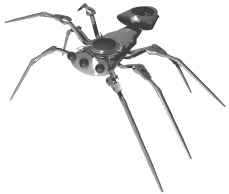
London , United Kingdom -- As soldiers take up secure positions behind a wall, they deploy a small reconnaissance team – a very small one. Some hopping, some flying, the stealthy autonomous reconnaissance squad vanishes into a suspicious building for several minutes, then relays the all-clear back to its relieved partners outside.
The chances of tiny intelligent mobile robots could someday assist U.S. armed forces and other personnel, such as search and rescue teams, are improving, thanks to a major research program led by BAE Systems. The team also includes scientists and engineers from the US Army Research Laboratory, industry partners, and several leading US research universities as well as international groups of researchers from the University of Sydney and the University of Milan.
Called the Micro Autonomous Systems and Technology (MAST) Collaborative Technology Alliance Program, the 10-year initiative is focused on creating the next generation of micro robotic systems. Discovering how nature can teach us how animals and insects sense their surroundings, manoeuvre around, over-and through obstacles and perform complex behaviours helps the team to understand how to convert these behaviours into digital inputs.
For example, how does a bee find its way back to the same flower and how does an animal like a gecko climb a vertical wall? How do ant colonies and packs of wolves work cooperatively to accomplish tasks that no one entity could accomplish alone and how do you design a robot with legs that can also function as antennas or whose body is also its power source?
“Our ultimate goal is to develop technologies that will give our soldiers another set of eyes and ears for use in urban environments and complex terrain, places where they cannot go or where it would be too dangerous,” explained Bill Devine, Advanced Concepts Manager with BAE Systems. “Our goal is also to develop technologies that will take maximum advantage of collaboration between multiple robots to accomplish missions that couldn’t be done by a single robot.”
The personal robots will be fully autonomous and equipped with a range of senors, including visual, audio, thermal, magnetic and chemical, as well as location and orientation capability to improve situational awareness for frontline troops by sending back vital, lifesaving information.
Prototypes have already been created by the team, including a fly-like robot that weighs less than an ounce and has a wing span of 1.18 inches – lightweight carbon joints allow the robot to mimic a real fly, with wings that beat 110 times a second.
BAE Systems
09.09.2009